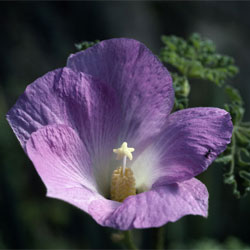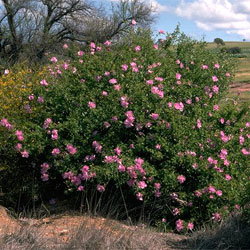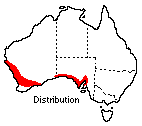Alyogyne huegelii
 |
 |
Lilac Hibiscus
Alyogyne huegelii (Endl.) Fryxell
Alyogyne huegelii (Lilac Hibiscus), formerly known as Hibiscus huegelii, and still found in many retail nurseries as such, is a rapid growing medium-sized shrub reaching about 2.5 m tall and almost equal breadth. It is found naturally in sandy to sandy-gravel areas of South Australia and Western Australia and although adaptable to a wide range of soil types, it is intolerant of bad drainage.
The specimens which are thriving best in the Australian National Botanic Gardens are those in fairly open positions and receiving sunlight for most of the day; they have some degree of wind protection from surrounding shrubs and trees. Most plants are growing in mulched, fairly heavy soil and are reasonably well drained, thus showing some adaptability from their natural occurrences of sand and gravel.
 A.
huegelii tends to become a little sparse of foliage on lower limbs if left
completely unpruned. After the main flowering flush in late spring the shrub
can be pruned back quite hard. This species has the desirable ability to throw
out vigorous, fast-growing shoots from old wood, thus enabling it to be kept
down to a small compact shrub if desired.
A.
huegelii tends to become a little sparse of foliage on lower limbs if left
completely unpruned. After the main flowering flush in late spring the shrub
can be pruned back quite hard. This species has the desirable ability to throw
out vigorous, fast-growing shoots from old wood, thus enabling it to be kept
down to a small compact shrub if desired.
The species belongs to the Malvaceae family and as such has one characteristic common to that family: the flowers open in the morning and last one day. Even so, the shrub is capable of producing hundreds of blooms per season. From late spring to the end of summer the species is covered in lilac flowers some 7 cm across with reddish-purple throats. Other colour forms found are violet, blue, rose pink and white.
The leaves are hairy, deeply three to five lobed and dull green in colour and can look attractive as long as the shrub is kept compact as previously stated.
Few pests have been noted, althought there is a report from the Gold Coast that plants have been partially defoliated by the larvae of a moth identified as Anomis flava. The larvae pupate in rolled up leaves on the plant *. Some protection from the hardest frosts is required.
The best way to propagate A. huegelii is by half-hardened tip cuttings 7-8 cm long, although soft tip cuttings also do well.
Text by ANBG staff (1976)
Name meaning: Alyogyne huegeliiAlyogyne - from the Greek alytos, united, undivided, and gyne, woman, ovary, alluding to the undivided style; huegelii - after Baron Karl von Huegel (1795 - 1870), a German naturalist who collected extensively in Australia. |
* Further information on this moth pest is available on:-
http://lepidoptera.butterflyhouse.com.au/calp/flava.html
![An Australian Government Initiative [logo]](/images/austgovt_brown_90px.gif)

